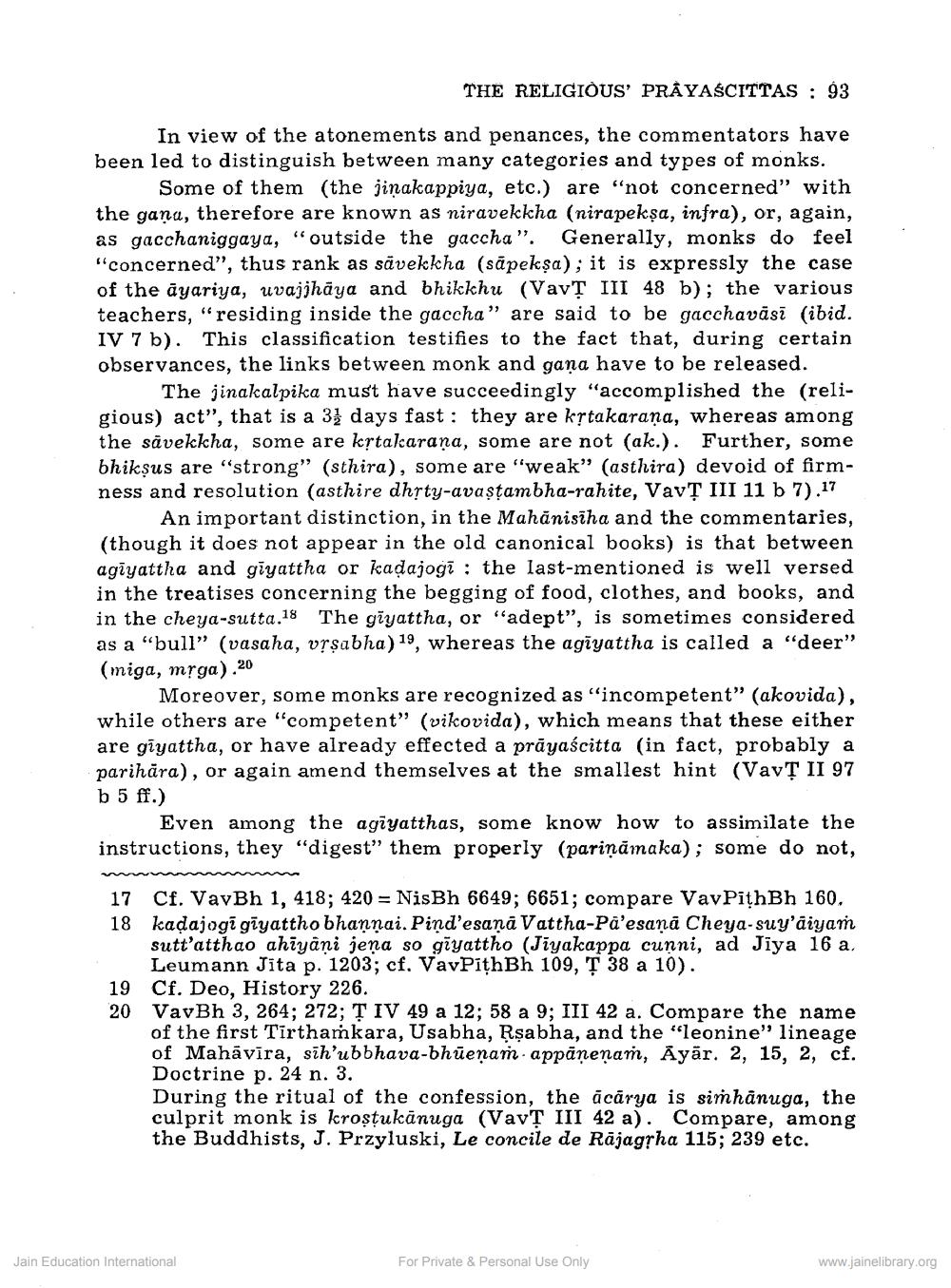Book Title: Religious Prayascittas according to old Jaina Ritual Author(s): Collete Caillat Publisher: Z_Mahavir_Jain_Vidyalay_Suvarna_Mahotsav_Granth_Part_1_012002.pdf and Mahavir_Jain_Vidyalay_Suvarna_ View full book textPage 6
________________ THE RELIGIOUS' PRÁYAŚCITTAS : 93 In view of the atonements and penances, the commentators have been led to distinguish between many categories and types of monks. Some of them (the jinakappiya, etc.) are "not concerned" with the gana, therefore are known as niravekkha (nirapeksa, infra), or, again, as gacchaniggaya, "outside the gaccha". Generally, monks do feel "concerned", thus rank as sāvekkha (sāpeksa); it is expressly the case of the āyariya, uvajjhāya and bhikkhu (VavȚ III 48 b); the various teachers, "residing inside the gaccha" are said to be gacchavāsī (ibid. IV 7b). This classification testifies to the fact that, during certain observances, the links between monk and gana have to be released. The jinakalpika must have succeedingly “accomplished the (religious) act”, that is a 3 days fast: they are kȚtakarana, whereas among the sávekkha, some are krtakarana, some are not (ak.). Further, some bhikṣus are "strong" (sthira), some are "weak” (asthira) devoid of firmness and resolution (asthire dhȚty-avaştambha-rahite, VavȚ III 11 b 7).17 An important distinction, in the Mahānisiha and the commentaries, (though it does not appear in the old canonical books) is that between agīyattha and giyattha or kadajogi : the last-mentioned is well versed in the treatises concerning the begging of food, clothes, and books, and in the cheya-sutta.18 The gīyattha, or "adept", is sometimes considered as a "bull" (vasaha, vrşabha) 19, whereas the agiyattha is called a "deer" (miga, mrga).20 Moreover, some monks are recognized as “incompetent" (akovida), while others are competent" (vikovida), which means that these either are giyattha, or have already effected a prāyaścitta (in fact, probably a parihāra), or again amend themselves at the smallest hint (VavŢ II 97 b 5 ff.) Even among the agīyatthas, some know how to assimilate the instructions, they "digest" them properly (pariņāmaka); some do not, 17 Cf. VavBh 1, 418; 420 = NisBh 6649; 6651; compare Vav PithBh 160. 18 kadajogi gīyattho bhannai. Pind'esaņā Vattha-Pa'esana Cheya-suy'aiyam sutt'atthao ahīyāņi jena so gīyattho (Jiyakappa cunni, ad Jiya 16 a. Leumann Jita p. 1203; cf. VavPithBh 109, T 38 a 10). 19 Cf. Deo, History 226. 20 VavBh 3, 264; 272; Ţ IV 49 a 12; 58 a 9; III 42 a. Compare the name of the first Tirthamkara, Usabha, Rşabha, and the "leonine" lineage of Mahāvīra, sih'ubbhava-bhūenam appāņenam, Ayar. 2, 15, 2, cf. Doctrine p. 24 n. 3. During the ritual of the confession, the ācārya is simhanuga, the culprit monk is krostukānuga (VavȚ III 42 a). Compare, among the Buddhists, J. Przyluski, Le concile de Rājagrha 115; 239 etc. Jain Education International For Private & Personal Use Only www.jainelibrary.orgPage Navigation
1 ... 4 5 6 7 8 9 10 11 12 13 14 15 16 17 18 19 20 21 22 23 24 25 26 27 28 29 30
